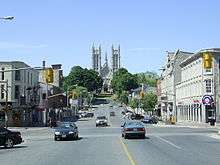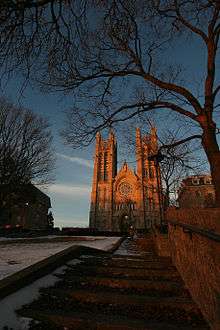Downtown Guelph

Downtown Guelph is the heart of the city of Guelph, Ontario. It is bordered by Wellington St. E. to the south, Woolwich St. to the East, Dublin St. to the west and Norwich St. to the North. Downtown Guelph is known for its distinctive limestone architecture and heritage buildings.
History
John Galt, founder of Guelph, assisted by his surveyor, planned the community. He plotted a series of large public "squares" of varied shape; this unique street design provided one of the earliest examples of town planning in Ontario.
Tradition relates that John Galt, or one of his companions, laid his outstretched hand on a tree stump and predicted that the streets of the new town would radiate from a central point such as his fingers radiated from his palm. It is true that the main streets of downtown Guelph do follow such a pattern, but which came first, the legend or the plan, remains in doubt.
Present day

Downtown Guelph is a relatively concentrated area compared to other downtowns which run in a straight line like a Main Street. Downtown is very easily accessible by car, regional and local transit, walking, and by bike. It is the home of Guelph's largest concentration of retail, dining, financial services, as well as entertainment, healthcare, and professional services like lawyers and doctors.
In recent years the area has been experiencing a renaissance as the Business Improvement Area (BIA) has brought in new retail, created Old Quebec Street, and improved the cleanliness. For entertainment there is the River Run Centre, a cinema at the Bookshelf Cafe, the Sleeman Centre (home of the Guelph Storm), and a colourful array of amateur musical acts performing weekly at each of the smaller clubs/bars. Historical sites and landmarks include the Basilica of Our Lady Immaculate, Guelph City Hall, The Armoury, Guelph train station, and Douglas Street.
Notable sites



There are many notable sites in Downtown Guelph, both historical and modern including:
- Sleeman Centre
- Church of Our Lady
- Guelph City Hall
- The Armoury
- Guelph Central Station
- Douglas Street
- Old Quebec Street Mall
- Wellington County Courthouse
- River Run Centre
- St. Georges Square
- Royal City Park
- Guelph farmers market
- Wilson Street
- Guelph Public Library
- Covered footbridge[2]
Architecture
Over the years many examples of fine architecture have contributed to the enrichment of the downtown area's unique appearance. Talented masons and builders made excellent use of the fine, warm-hued limestone which was so easily worked by stone carvers. The local limestone has contributed a splendid unity and visual distinction to the architecture of the community. Many fine examples of historic stone architecture remain intact and in a state of commendable preservation.
The post-World War II era saw many older buildings in St. Georges Square demolished and replaced by modern buildings. Other parts of downtown also had these modern pieces put in. Citizens rallied to start saving downtown Guelph's historic buildings and have protected many from being lost.
Education
Downtown Guelph used to be home to one high school, Bishop Macdonnell, which sat beside the Church of Our Lady. There is currently one public school within the downtown core, Central Public School located on Dublin Street
Guelph Public Library
In 1882, the Ontario government passed the Free Libraries Act, allowing municipalities to establish libraries supported by local taxes. The City of Guelph was the first in Ontario to take advantage of this Act. The Guelph Library attempted to seek suitable quarters and moved to its current location on the corner of Norfolk and Paisley. Guelph was one of the first communities to take advantage of grants made available by steel magnate Andrew Carnegie.
Guelph is served by a growing library system composed of a main branch located in the downtown core, five branches and a Bookmobile. It holds a membership of over 85,000, the Guelph Public Library system's goals include preserving and indexing public materials relating to the history of Guelph. Although no formal program has been developed, the library acquires municipal records of archival value from the City of Guelph.
The Guelph Public Library also offers a number of programs including a book club.
Transportation

Downtown is home to Guelph Central Station which combines local bus service of Guelph Transit with Via Rail, GO Transit, and Greyhound Canada services. Downtown is also easily accessible by bike, with bike paths connecting residents from all sides of the city into the centre.
Gallery
-

View of the Church of Our Lady from Macdonell St.
-

View of Macdonell St. in Downtown Guelph
-

Guelph City Hall
-

Church of Our Lady Immaculate
References
- ↑ http://www.pc.gc.ca/apps/beefp-fhbro/FHB_Rech_Search_e.asp Register of the Government of Canada Heritage Buildings.
- ↑ Covered Bridge
External links
Coordinates: 43°32′45″N 80°14′57″W / 43.54583°N 80.24917°W